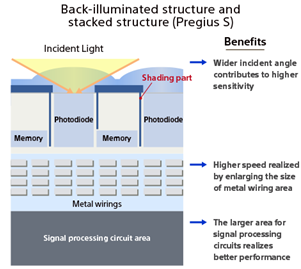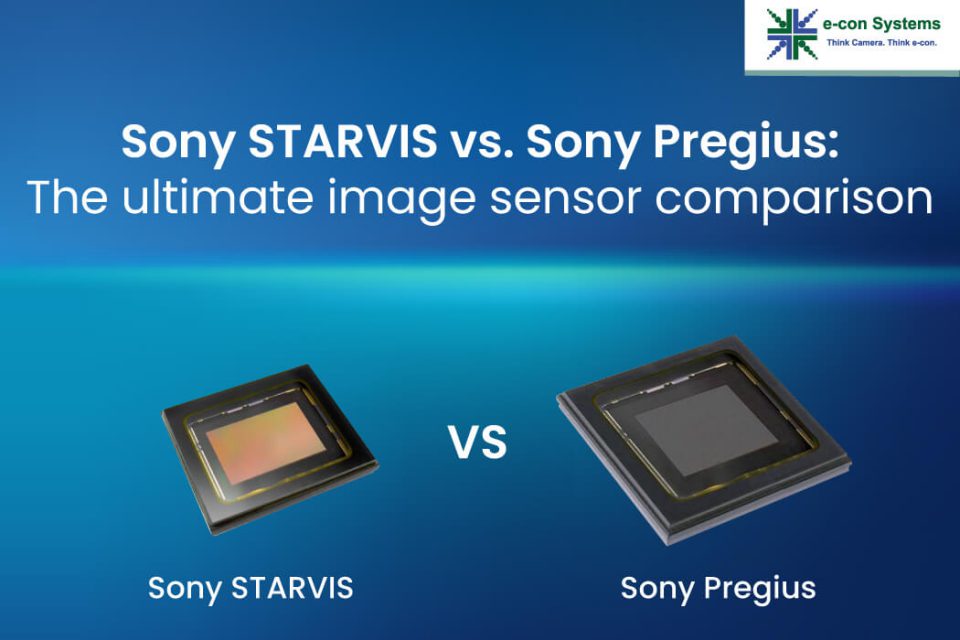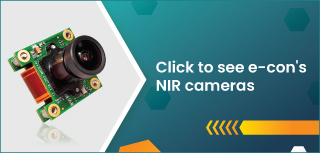Recent advancements in image sensor technology point to a clear trend that has seen the rise of a wide range of applications such as smart surveillance, smart traffic monitoring, agricultural robots, medical and life science devices, and so on. Each application has its own requirements, such as high frame rate, high dynamic range, high SNR, global shutter, etc.
As you may have heard, Sony STARVIS and Sony Pregius sensors outperform older CCD sensors in every way and are a more cost-effective option. But what are the similarities and differences between these two popular sensors? Where are they used? And does e-con System have a camera solution based on the best camera sensor in the market today?
Get all the answers in our latest blog!
What are Sony STARVIS and Sony Pregius?
Sony STARVIS comes with a backside-illuminated (BSI) technology used in CMOS image sensors for surveillance camera applications. It has a sensitivity of 2000 mV (color product and when imaging with a light source of 706 cd/m2, F5.6 in 1s accumulation equivalent). It can help produce high-quality images in visible and near-infrared (NIR) light regions. Moreover, Sony STARVIS is available in both monochrome and RGB versions.
On the other hand, Sony Pregius is also a series of cutting-edge CMOS image sensors. It features a global shutter pixel technology based on Sony’s low-noise CCD structure.
Structure and architecture of Sony STARVIS and Pregius Sensors
As discussed earlier, Sony STARVIS features a back-illuminated structure that enables super-high sensitivity. This structure increases the depth of a photodiode and modifies the structures and materials of the walls between photodiodes. As a result, the amount of light to be captured increases while offering features like sensitivity and HDR.
In addition to the above enhancements, the on-chip lens has improved light concentration and transmittance, the color filter has higher transmittance, and the photoelectric conversion efficiency has been enhanced.
Look at the image below to understand the difference between the evolution of Sony STARVIS and STARVIS 2.
 Figure 1: Structure of Sony STARVIS and STARVIS 2 (source: Sony)
Figure 1: Structure of Sony STARVIS and STARVIS 2 (source: Sony)
The key specifications of Sony STARVIS and STARVIS 2 sensors are listed in the table below.
| Feature | STARVIS | STARVIS 2 | |
| IMX290 | IMX327 | IMX585 | |
| Size (inch) | 1/2.8 | 1/2.8 | 1/1.2 |
| Pixel Size | 2.9µm | 2.9µm | 2.9µm |
| Resolution | 2.13M | 2.1MP | 8.3 MP |
| Frame rate (fps) | 120 | 60 at 12-bits | 90 at 10-bit |
| G Sensitivity (digits) | 5486 | 10741 | 5970 |
| Read Noise | 0.7e | low | 0.8e |
| Dynamic Range | < 75db | < 72 dB | 88 dB |
| Quantum Efficiency | 77% | >75% | 91% |
Table 1: Sony STARVIS Key Specifications
Pregius, as the name denotes, represents the combination (Precision GS) of the CCD’s low-noise performance of CCD with the high-speed and high-precision performance of global shutter (GS). Sony released their first Pregius CMOS sensor, the 2.3 MP (1936 x 1216) IMX174, in 2013. Today there are four generations of Sony Pregius CMOS sensors. Sony Pregius S is the name given to the fourth generation of this sensor series. Its design is a combination of BSI and a stacked structure. It has a wider incident angle, which contributes to higher sensitivity. The sizes of the metal wiring area and signal processing circuits are enlarged, resulting in higher speed and better performance.
Look at the below image to understand the structure of Sony Pregius S.

Figure 2: Structure of Sony Pregius S (source: Sony)
Each generation of Sony Pregius has a unique dynamic range saturation capacity, temporal read noise, and quantum efficiency. The pixel size also varies by generation: 5.86µm for the first generation, 3.45µm for the second generation, 4.5µm for the third generation, and 2.74µm for the fourth generation. In the Sony Pregius S sensor, a smaller pixel size of 2.74 μm allows higher resolutions into smaller pixel sizes. In general, the pixel size determines the number of pixels that can fit into a given sensor size and the performance characteristics of the image quality. A larger pixel size is associated with saturation capacity and temporal dark noise. This sensor ensures a minimum dynamic range of ~70 db across generations.
The key specifications of the Sony Pregius sensor are listed in the table below.
| Pregius Generation Pixel Size |
Avg Saturation Capacity |
Saturation Capacity (e-/µm^2) |
Avg Read Noise |
Avg Dynamic Range |
| 1st Gen: 5.86µm | 33000 e- | 961 | 7 e- | 70 dB |
| 2nd Gen: 3.45µm | 10500 e- | 882 | 2.3 e- | 71 dB |
| 3rd Gen: 4.5µm | 25000 e- | 1235 | 5.5 e- | 72 dB |
| 4th Gen: 2.74µm | 9500 e- | 1265 | 2.1 e- | 71 dB |
Table 2: Pregius Generation Comparison (Source: thinklucid)
Sony STARVIS and Sony Pregius Sensors: A detailed comparison
Let us look at the similarities and differences between Sony STARVIS and Sony Pregius sensors along the following parameters:
- Global shutter
- NIR performance
- Dynamic range
- Quantum efficiency
- Triggering speed
Global Shutter
Previous CMOS sensors used rolling shutter technology for pixel data readout. This technology offers low-cost, high-quality imaging at very high frame rates. Unfortunately, the captured images exhibit distortion when the target or camera moves. This distortion is referred to as rolling shutter artifacts, and it occurs as a result of the rolling shutter sensor exposing and reading out pixels one row at a time.
Also, Read: Rolling Shutter vs. Global Shutter
In the case of Sony Pregius, the resulting image has no distortion. Let’s see how this plays out.
The Sony Pregius CMOS global shutter pixel pipeline employs an analog memory node between the photodiode and floating diffusion node. So, each photodiode senses the light simultaneously. The electrons flow into the analog memory when the photodiodes have finished their exposure, freeing them for the following exposure. The functionality of the CMOS global shutter is made possible by this process. This global shutter feature in the camera is a must-have feature for following applications.
- Digital microscopy
- Fluorescence imaging
- Live cell imaging
- Agricultural robots
- Auto farming equipment
NIR Performance
The camera’s NIR imaging performance is defined as its ability to capture high-quality images in the near-infrared region. The Sony STARVIS camera sensor is well known for its superior NIR sensitivity and commonly preferred by manufacturers for the below applications.
- Smart surveillance – people counting, crowd analytics, vehicle counting, etc.
- Smart traffic monitoring – vehicle counting, automated number plate recognition, etc.
- Agricultural applications
- Night vision applications
- Medical microscopes – Fluorescence microscopy,
Sony Pregius also achieves excellent imaging performance for NIR wavelengths.
Look at e-con Systems’ cameras that help capture images even in extreme low-light conditions (0 lux).
Dynamic Range
Dynamic range is the ratio of maximum to minimum measurable light intensities (white and black, respectively). With more than 8 dB in a single exposure, Sony STARVIS 2 has a greater dynamic range (AD 12bit) than a STARVIS pixel of the same size. On the other hand, Sony Pregius sensors’ third generation offers a maximum dynamic range of 76 dB utilizing the large capacity pixels design combined with a new feature called Dual ADC. This Dual ADC captures high and low-gain images on the same frame.
The output can be combined on the preferred industrial camera’s ISP. For embedded vision applications such as robotics, advanced driver assistance, drones, medical diagnosis, entertainment, security, and factory automation, a greater dynamic range is typically required.
Quantum Efficiency
Quantum efficiency (QE) is the sensor’s ability to convert photons into electrons. In general, the sensor’s QE increases with the light-sensitive portion. However, when comparing the QE among generations of Sony Pregius sensors, the third generation offers peak QE closer to 1st generation results and greatly improves efficiency over the entire range.
On the other hand, a sensor with Sony STARVIS 2 technology also achieves exceptional quantum efficiency, as mentioned in table 1. High quantum efficiency is crucial for a wide range of applications, including fluorescence microscopy, displays, lasers, and solar cells.
Read More: What is the role of high QE cameras in medical and life science applications?
Triggering speed
Image capturing/imaging operation will be triggered by providing an electrical pulse to the camera’s trigger pin. The triggering needs to be as quick and accurate to capture fast-moving objects. In this case, Sony Pregius sensors perform better than Sony STARVIS series sensors. Pregius sensors take lesser time to trigger and read out an image, but STARVIS sensors can take more time.
This fast and precise timing is vital in industries that demand the inspection of very fast-moving objects, motion analysis in sports, and when examining fast-moving biological processes, such as the contraction of muscle fibers or the movement of cells.
e-con Systems’ latest Sony Pregius IMX264 CMOS sensor-based See3CAM_50CUG Camera
See3CAM_50CUG is a 5MP high-sensitivity fixed focus camera based on the Sony Pregius IMX264 CMOS sensor. It enables a pixel size of 3.45 µm and supports global shutter technology. This camera is designed to meet the diverse needs of your medical and life science applications. This USB camera can capture high frame rate images without any motion blur, and its IR sensitivity helps to produce stunning image quality even in the Near Infrared (NIR) regions. This plug-and-PLAY camera (UVC compliant) for Windows and Linux also comes with a C-mount lens holder, allowing customers to select and use the lens that best suits their needs.
Sony Exmor and STARVIS sensor-based cameras from e-con Systems™
e-con Systems™ offers a wide portfolio of Sony cameras based on sensors like IMX290, IMX298, IMX327, IMX412, IMX415, IMX462, and IMX485.
Here’s a complete list of camera modules and cameras offered by e-con Systems™ based on Sony Exmor and STARVIS sensors:
- e-CAM160A_CUMI298_MOD – 16 MP Sony IMX298 autofocus camera module
- e-CAM120_CUMI412C_MOD – 12 MP Sony STARVIS IMX412 low light camera module
- e-CAM84_CUMI485C_MOD – Sony STARVIS IMX485 ultra low light camera module
- e-CAM83_CUMI415_MOD – Sony STARVIS IMX415 4K ultra low light camera module
- e-CAM221_CUMI462_MOD – Sony STARVIS IMX462 ultra low light NIR camera module
- e-CAM220_CUMI327_MOD – Sony STARVIS IMX327 camera module
- e-CAM21_CUMI290_MOD – Sony STARVIS IMX290 low light camera module
- See3CAM_CU27 – Sony® STARVIS™ IMX462 ultra low light USB 3.1 Gen 1 camera
- e‑CAM82_USB– SONY STARVIS™ IMX415 4K Ultra-HD USB Camera
- e-CAM80_CUNX– SONY 4K Camera for NVIDIA® Jetson Xavier™ NX/Nano
- e-CAM80_CUOAGX– 4K Camera based on SONY IMX415 for NVIDIA® Jetson AGX Orin
- qSmartAI80_CUQ610– Qualcomm® Edge AI Vision Camera
You can also check out our Camera Selector page to see our entire portfolio of cameras.
If you require assistance with integrating camera solutions into your vision-based application, please email to camerasolutions@e-consystems.com.

Balaji is a camera expert with 18+ years of experience in embedded product design, camera solutions, and product development. In e-con Systems, he has built numerous camera solutions in the field of ophthalmology, laboratory equipment, dentistry, assistive technology, dermatology, and more. He has played an integral part in helping many customers build their products by integrating the right vision technology into them.



